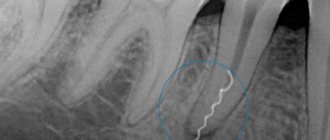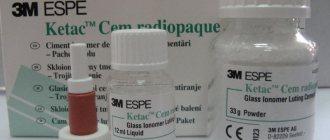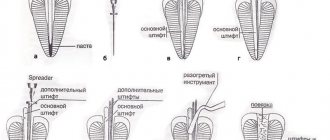Canal unsealing is a dental procedure that is aimed at removing a previously installed filling. Another name for it is “disobturation”. The process requires expansion of the canals in the direction from the crown to the apex of the root for the purpose of high-quality cleaning of dental cavities. The procedure is resorted to after endodontic treatment carried out with violations of technology. It must be carried out on time, since infectious agents that have penetrated the dental tissues will provoke the development of inflammatory processes, which, in turn, can cause the loss of the entire tooth.
The therapeutic department of dentistry CELT invites you to undergo root canal retreatment in Moscow. Our clinic is multidisciplinary and has been offering paid medical services for more than two decades. Our dental therapists have a modern diagnostic and treatment base in their arsenal, thanks to which they are able to accurately and promptly make diagnoses and carry out treatment in accordance with international standards. You can find out the approximate price for unsealing canals by going to the “Services and Prices” tab. We regularly update the price list, but in order to avoid misunderstandings, we recommend that you check the exact numbers with our operators or at a doctor’s appointment.
Consultation with a dentist-therapist - 1,000 rubles.
Unsealing a previously obstructed canal (1 canal) - RUB 3,000.
Unsealing the canal under the stump tab - 1,700 rubles.
At CELT you can get advice from a dental specialist.
- The cost of a consultation with a dentist-therapist is 1,000
Make an appointment
Features of dental canal treatment
Differences in the structure and functions of the “representatives” of the dentition largely determine the nature of the treatment approach. Treatment of canals for different groups of teeth has its own nuances.
Front tooth canal treatment
The front teeth most often have one canal. They are often curved and difficult to pass through for instruments. In order to preserve aesthetics, the opening of the cavity of these teeth is carried out from the vestibule of the oral cavity. Due to their frontal location, it is important to prevent tooth enamel from darkening, so filling materials containing dyes are not used.
Treatment of wisdom tooth canals
Wisdom teeth can have more than 5 canals; they often have a branched structure, which is not always revealed by x-ray examination. These factors, along with the marginal location of the “eights”, significantly complicate the high-quality treatment of root canals. At the final stage of treatment, various filling pastes are traditionally used.
Root canal treatment of temporary teeth
Endodontic treatment of tooth root canals is usually used only at the stage of root stabilization. When choosing the optimal treatment tactics, it is necessary to take into account the specific structure of temporary teeth. The small thickness of the canal walls, the insignificant degree of dentin mineralization and the relatively large size of the apical foramen are the main reasons for special caution during instrumentation. Zinc oxide eugenol and iodoform pastes, as well as materials based on calcium hydroxide, are usually used as filling agents. They are not toxic to the permanent tooth germ and are able to dissolve along with the temporary root.
Stages of tooth canal treatment
Endodontic treatment usually lasts several hours and includes a number of stages.
- Removal of the pulp (pulpectomy).
The inflamed soft tissue of the tooth is eliminated. - Root canal sanitation.
The procedure is a “cleaning” of bacteria and dead tissue elements. Pulpectomy and canal sanitation pursue one of the most important goals - eliminating existing inflammation. - Channel formation.
The root canal, freed from pathological contents, undergoes appropriate treatment. In addition to ensuring good passage of the canal, it is imperative to ensure that its apex reaches the apical part of the tooth. - Canal filling.
The last stage of the intervention is filling the root canal with filling material, followed by grinding.
Modern methods
Two main unsealing methods are used:
- Chemical. Involves the use of solutions, pastes or gels containing organic elements that soften the filling material and make it accessible to removal with endodontic instruments (K- and H-files, K-reamers).
- Mechanical (hardware, instrumental) using endodontic and other equipment or tools.
With any method of unsealing, the oral cavity is first treated with antiseptics and access is created by mechanical treatment with burs, root reamers, and drills.
Using the devices
You can completely or partially remove the old filling using ultrasonic endo-nozzles. These devices, which generate sound pulses, are designed to remove tartar and clean canals.
The advantage of using ultrasound when removing old fillings is the ability to selectively and carefully remove pathological areas , while preserving healthy tooth tissue or filling material, which must be left in place.
It is especially advisable to use ultrasound for unsealing channels for the installation of central pins , since in this case the filling material should not be completely removed, but partially.
How to unfill canals with ultrasound, see the video.
Treatment of teeth with problematic root canals
Filling dental canals
A relatively simple technology for treating tooth canals is filling with a special paste with or without a pin. According to the “gold standard” of endodontics, the canals are also filled with a latex-like material - gutta-percha. Several methods of its use have been developed, including the Termafil system, lateral condensation, injection or liquid thermogutta-percha (vertical condensation). In some cases, in particular when treating a tooth canal cyst, filling is carried out with a substance based on calcium hydroxide (copper-calcium hydroxide “depopheresis” method). However, special nanocomposite materials are increasingly used in dentistry.
Treatment under a microscope
The age-old “tough nut to crack” for the dentist is curved or branched root canals of the teeth. A dental microscope, often in combination with a laser, allows you to completely pass through them and adequately process them along their entire length to reduce tissue trauma. Sometimes it becomes necessary to treat a sealed tooth canal with the evacuation of remaining material of various nature, for example, fragments of fillings, tissue fragments and even instruments. Then a microscope also comes to the rescue. Read more about the technology in a separate article.
Closing Methods
There are many methods of root canal obturation; the choice of a specific one is determined by the clinical situation. The most common technologies include the following:
- filling with gutta-percha (vertical and lateral condensation, obturation from a syringe, etc.);
- one paste;
- with installation of a central pin;
- on a carrier (thermophile system).
Gutta-percha filling
There are 2 methods of obturation with gutta-percha resin.
- Lateral (side) condensation . It is a sequential introduction of several (usually 4-5 pieces) cold gutta-percha pins with each one pressed into the wall with a spreader.
- Vertical condensation . The method involves pressing gutta-percha pins in the axial direction using hot instruments (pluggers), which heat the gutta-percha and press it into the canal, ensuring that all cavities are filled.
Both methods are considered effective and reliable.
The following advantages of gutta-percha as a filling material are noted:
- predictability of obturation;
- gutta-percha is indifferent and non-allergenic (does not irritate tooth and gum tissue);
- preservation of properties for an indefinitely long time;
- radiopacity, which allows you to control the quality of filling using fluoroscopy;
- ease of removal from the canal (if necessary).
Gutta-percha also has disadvantages:
- the material does not have an antibacterial effect;
- requires high professionalism of the dentist.
Filling with one paste
Typically, hardening pastes based on zinc oxide eugenol or resorcinol-formaldehyde resin are used. The cavities are filled using a channel filler or manually.
In the latter case, the following technology is most often used:
- the walls of the prepared channel are lubricated with the solvent on which the paste was mixed.
- a portion of material is introduced at the tip of the endotool.
- The paste is compacted with a turunda wound around the instrument.
- the next portion is introduced with compaction - and so on until the channel is completely filled.
- Excess paste above the mouth is removed.
The advantages of filling with one paste are:
- technological simplicity;
- comparative cheapness;
- Possibility of use in narrow and curved passages.
There is only one drawback, but a serious one - the lack of guarantee of reliable obturation.
Indications for conduction anesthesia in dentistry and procedure techniques.
In this publication we will announce the price of a panoramic dental photograph.
Here https://zubovv.ru/lechenie/zubyi/plombyi/kakie-problemyi-reshayut-svetovyie-na-perednih.html read about the benefits of using light fillings on the front teeth.
Filling with installation of an intracanal pin
The method is recommended for channels that are round in shape, ensuring a tight fit of the pin to the shades. Sequence of work:
- selection of a pin with dimensions corresponding to the standard size of the master file (the tool used to make the last pass during cleaning);
- adjusting the pin - fitting, trimming, bending, if necessary, in accordance with the shape of the channel;
- inserting a portion of paste into the cavity using endoinstruments;
- coating the pin with sealing paste and inserting it into the stock;
- removing air by slow back-and-forth movements of the pin.
Filling using the Thermofil system
The technology is based on the use of an obturator - a plastic carrier filled with gutta-percha, which is sometimes called the same as the system itself - “Thermophile”.
The set of materials and equipment includes:
- obturator;
- verifier (plastic carrier without gutta-percha, used for selecting an obturator).
- thermophile heating oven;
- sealant (thermostable materials like Tseal, H-Plus, etc.).
Filling technology
Obturation is performed under anesthesia due to the possibility of pain caused by the peculiarities of the technology.
- Calibration of the channel by the verifier and selection of a thermophile based on it.
- Injection of sealant into the cavity on a paper pin or thin file of sealant.
- Heating the obturator in the oven (the plastic state is maintained for about 15 seconds).
- Injection of thermophile into the channel.
- Pause 2-4 minutes for gutta-percha to cool.
- Trimming the obturator handle to ensure that the tip is raised by 1-2 mm (needed to remove the thermophile if the filling is unsuccessful).
- If necessary, thermophile obturation can be supplemented with lateral condensation.
- Installation of a temporary filling.
But complete curing of thermophile requires 1-3 days.
Advantages of the “thermophile” system:
- efficiency and reliability (the method is considered one of the most advanced):
- allows you to fill all narrow branches from the main canal with gutta-percha.
- Flaws:
- not recommended for canals with a taper of less than 04 and without an apical stop.
If your tooth hurts after root canal treatment
If after root canal treatment your tooth hurts when you press it, this is normal. This phenomenon is associated with insufficient anesthesia in the area of endodontic intervention. Another reason why a tooth hurts after canal treatment is excessive treatment with the instrument moving beyond the apical foramen.
How long does a tooth hurt after root canal treatment? Sometimes pain persists for several days due to intensive intervention in the tissue structure in such a limited area. A similar situation occurs when an excess amount of filling material is placed into the canal, which causes discomfort when pressure is applied to the walls. As a result, the tooth “aches” after canal treatment. In any case, the presence of post-filling pain signals the need for a second visit to the dentist.
Description of the procedure
- Local snapshot. X-ray allows you to see the condition of all channels, their number, location. In difficult cases, a 3D image is taken.
- Anesthesia.
- Drilling of diseased tooth tissues.
- Removal of nerve and blood vessels.
- Determining the depth of the canal using an apexolator.
- Widening the passage to place the drug and install the pin (if required).
- Filling.
- Control photo.
After treatment, it is not recommended to consume hot drinks and food for 1 – 2 hours.
Possible complications
Not all cases go smoothly. Let's consider the main problems that arise after the procedure.
- Perforation.
The phenomenon is the formation of holes between the dental canals and surrounding tissues. Treatment of perforation consists of medicinal treatment and filling. - Cheek swelling.
The reason why the cheek is swollen after root canal treatment is believed to be the impregnation of the periodontal tissues and mucous membranes with an anesthetic drug, which themselves are quite loose and easily absorb liquid. - Instrument fracture.
The probes for passing through the channels are very thin. If they break during medical procedures, the fragments are removed with special devices. Modern dental instruments made of nickel-titanium alloys are less susceptible to wear and break less often. - Adverse reactions to medications.
The range and severity of side effects of modern anesthetics are minimal. Before treatment, the doctor must collect an allergic history - information about drug intolerance - and the likelihood of a full-blown allergic reaction is practically reduced to zero. Adverse reactions of moderate and minor degrees are mostly short-term, can be easily corrected or can be overcome by changing the drug. - Other complications.
Situations such as swallowing particles of fillings, tooth dust, and small instruments now practically do not occur thanks to the use of a rubber dam - a latex plate that separates the tooth or teeth being treated from the oral cavity.
Temporary filling
In some cases, medicine is introduced into the canals for a certain period of time. Manipulation is carried out for:
- elimination of pathological microflora;
- stopping the inflammatory process;
- isolation of the canal, when it is impossible to carry out treatment in one visit.
Indications for temporary installation of a filling are injuries, perforation of walls, periodontitis in acute or chronic form.
The main active components of medicinal non-hardening pastes are antibiotics.
When is tooth extraction necessary after root canal treatment?
It happens that you have to part with a treated tooth. Typically, such a sad outcome is due to the following factors:
- initially unsatisfactory root canal treatment with the development of poorly controlled inflammation;
- some cases of wisdom teeth treatment;
- the complexity of the anatomical structure of roots and canals in a particular patient;
- late request of the patient for specialized help, in which adequate therapeutic measures do not lead to the desired result.
Reviews
Diseased teeth can cause very serious pathologies not only in the oral cavity, but in almost any organ.
Timely filling and re-treatment of teeth can save you from major health problems.
If you have had to use canal deobturation, share your impressions of this procedure with our specialists and patients, please leave a comment at the bottom of this page.
If you find an error, please select a piece of text and press Ctrl+Enter.
Tags seals unsealing channels
Did you like the article? stay tuned
No comments yet
What is the cost of treatment?
How much does root canal treatment cost? The cost largely depends on the method used and the quality of the materials. When using laser and microscopic technology, nanocomposites and other advanced developments, the cost of tooth treatment with canal filling increases significantly. Approximate prices for root canal treatment in Moscow with gutta-percha filling and composite filling are presented in the table below.
| View | Price |
| Single channel tooth | 9,500 – 12,5000 rubles |
| Double channel tooth | 11,000 – 14,500 rubles |
| Three-channel tooth | 13,500 – 17,000 rubles |
The cost of root canal treatment should not be the determining factor in choosing a clinic. Contact only dentistry with a good reputation and experienced specialists who use modern equipment and the latest techniques in their work. Remember - the future fate of your teeth and the aesthetics of your smile depend on the quality of canal treatment!










